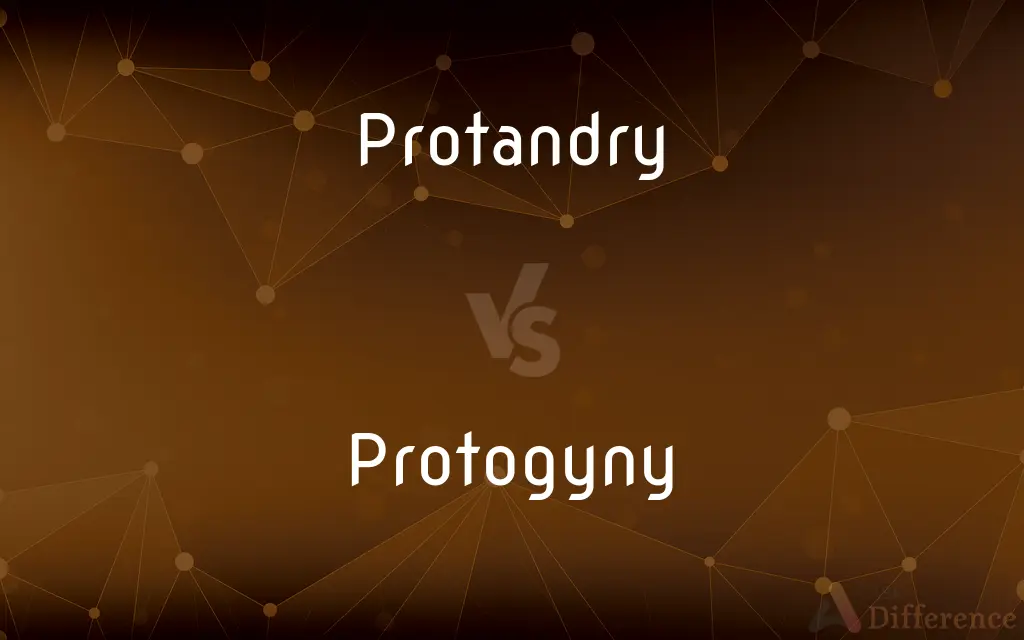Protandry vs. Protogyny — What's the Difference?
By Tayyaba Rehman & Urooj Arif — Updated on April 1, 2024
Protandry and protogyny refer to sequential hermaphroditism in animals: protandry is when an organism starts life as male and changes to female, whereas protogyny is the opposite, beginning as female and becoming male.

Difference Between Protandry and Protogyny
Table of Contents
ADVERTISEMENT
Key Differences
Protandry is a reproductive strategy observed in some animal species where individuals initially mature as males and later transform into females. This adaptation can optimize reproductive success under certain environmental or social conditions, such as scarcity of females or changes in the individual's size or age. On the other hand, protogyny involves organisms starting their lives as females and later changing to males, often influenced by similar factors like social hierarchy or the need to maximize reproductive output as the organism grows larger and can produce more sperm.
In protandry, the early male phase allows the organism to begin reproducing quickly with a lower energy investment required for sperm production compared to egg production. As the organism grows and accumulates more resources, it switches to the female role to produce eggs, which require more energy but also offer a greater potential for offspring. Whereas, protogyny allows larger, more dominant individuals to assume the male role, capitalizing on their size to control access to multiple females, thereby increasing their reproductive success.
The ecological rationale behind protandry and protogyny often relates to the mating system and population dynamics of the species. Protandry can be advantageous in populations where large females have higher reproductive success due to their ability to produce more eggs. Conversely, protogyny may be favored in situations where larger males can monopolize breeding opportunities with several females, thus ensuring their genes are widely disseminated.
Despite their differences, both strategies showcase the remarkable adaptability of certain species to their environments, highlighting the complexity of reproductive strategies in the natural world. By switching gender , these organisms can maximize their reproductive potential across different stages of their life, ensuring their survival and continuity under varying environmental pressures.
Comparison Chart
Definition
The phenomenon where an organism starts life as a male and changes to female.
The phenomenon where an organism starts life as female and changes to male.
ADVERTISEMENT
Ecological Rationale
Optimizes reproductive success when small males have advantages in mating.
Favors scenarios where larger males dominate breeding opportunities.
Energy Investment
Initial low energy investment in sperm production, shifting to higher investment in egg production.
Starts with high energy investment in egg production, shifting to sperm production as organism grows.
Influencing Factors
Often triggered by the absence of females or an abundance of males.
Triggered by environmental or social factors, such as the removal of a dominant male.
Examples
Certain fish species, like clownfish.
Wrasses and some reef fish exhibit protogyny.
Compare with Definitions
Protandry
Found in various animal groups, including insects and fish.
Protandry is observed in butterfly species, where early male phases help spread genes quickly.
Protogyny
A reproductive adaptation where organisms start as females and become males.
Protogyny in reef fish allows for efficient use of resources by changing roles as they grow.
Protandry
Occurs under specific environmental or social conditions.
Protandry often arises in species with skewed gender ratios, ensuring reproductive roles are filled.
Protogyny
Often seen in species where larger males control access to females.
In protogynous species, larger, older individuals often dominate breeding as males.
Protandry
Maximizes reproductive success across life stages.
Protandry in some species is a response to changing conditions, allowing older, larger individuals to produce more offspring as females.
Protogyny
Common in certain fish and plant species.
Many reef-dwelling fish exhibit protogyny, adapting to social and environmental pressures.
Protandry
A reproductive strategy where organisms change from male to female.
In clownfish, protandry allows smaller males to initially reproduce until they become dominant females.
Protogyny
Ensures genetic diversity and maximizes offspring.
Protogyny can increase genetic diversity by allowing dominant individuals to mate with multiple females.
Protandry
Of or relating to an organism, especially a plant, in which the male reproductive organs mature before the female reproductive organs.
Protogyny
Of or relating to an organism, especially a plant, in which the female reproductive organs mature before the male reproductive organs.
Protandry
Of or relating to the earlier arrival of males than of females at a breeding site
Protandrous migration.
Protogyny
(biology) The condition in which an organism begins life as a female and then changes into a male.
Protandry
(biology) The condition in which an organism begins life as a male and then changes into a female.
Protogyny
(botany) The condition of flowers whose female parts mature before the male ones.
Protandry
(botany) The condition of flowers whose male parts mature before the female ones.
Protandry
(ethology) The arrival of males before females at a mating site.
Common Curiosities
Why do some species exhibit protandry?
Protandry is often advantageous in conditions where being a small male initially and a larger female later can maximize reproductive output.
Is protandry or protogyny more common?
The prevalence of protandry versus protogyny varies by species and environmental context; both strategies are adaptive responses to specific reproductive challenges.
What triggers a gender change in protogynous species?
Environmental factors, such as the absence of dominant males, or social cues within the population can trigger protogyny.
What ecological benefits does protogyny offer?
Protogyny allows for larger, more dominant individuals to become males, efficiently spreading their genes by mating with multiple females, which can enhance the genetic diversity and resilience of the population.
What role do protandry and protogyny play in evolutionary biology?
These reproductive strategies offer insights into the flexibility of reproduction and how organisms adapt to their environments to maximize reproductive success, contributing to our understanding of evolutionary biology.
What is sequential hermaphroditism?
Sequential hermaphroditism is when an organism changes its gender during its lifetime, a strategy that includes protandry and protogyny.
Are there specific environmental conditions that favor protandry or protogyny?
Yes, protandry is often favored in stable environments where early male reproduction and later female egg production can be optimized. Protogyny tends to be favored in environments where larger males can better compete for and monopolize females.
How does protandry affect population dynamics?
Protandry can balance gender ratios in populations, ensuring there are enough breeding females later in life to produce offspring, thereby stabilizing the population.
What is the difference between simultaneous hermaphroditism and sequential hermaphroditism?
Simultaneous hermaphrodites possess both male and female reproductive organs at the same time, while sequential hermaphrodites change gender at some point during their lifespan.
Do protandry and protogyny occur outside of aquatic environments?
Yes, while these phenomena are most commonly studied in aquatic species, such as fish and some invertebrates, they can also occur in terrestrial species, including certain plants and invertebrates.
Share Your Discovery

Previous Comparison
Hexene vs. Hexaene
Next Comparison
Damages vs. CompensationAuthor Spotlight
Written by
Tayyaba RehmanTayyaba Rehman is a distinguished writer, currently serving as a primary contributor to askdifference.com. As a researcher in semantics and etymology, Tayyaba's passion for the complexity of languages and their distinctions has found a perfect home on the platform. Tayyaba delves into the intricacies of language, distinguishing between commonly confused words and phrases, thereby providing clarity for readers worldwide.
Co-written by
Urooj ArifUrooj is a skilled content writer at Ask Difference, known for her exceptional ability to simplify complex topics into engaging and informative content. With a passion for research and a flair for clear, concise writing, she consistently delivers articles that resonate with our diverse audience.














































